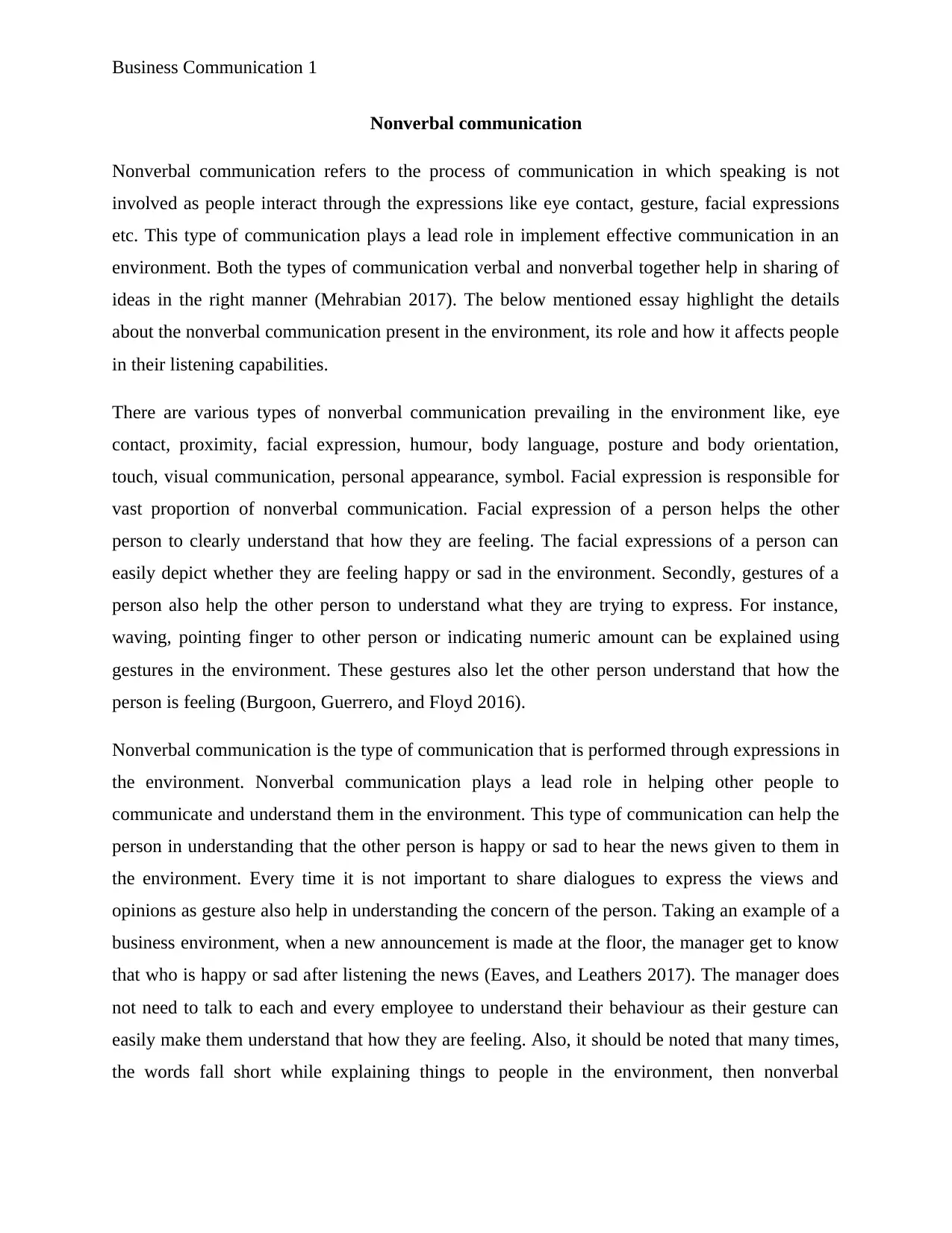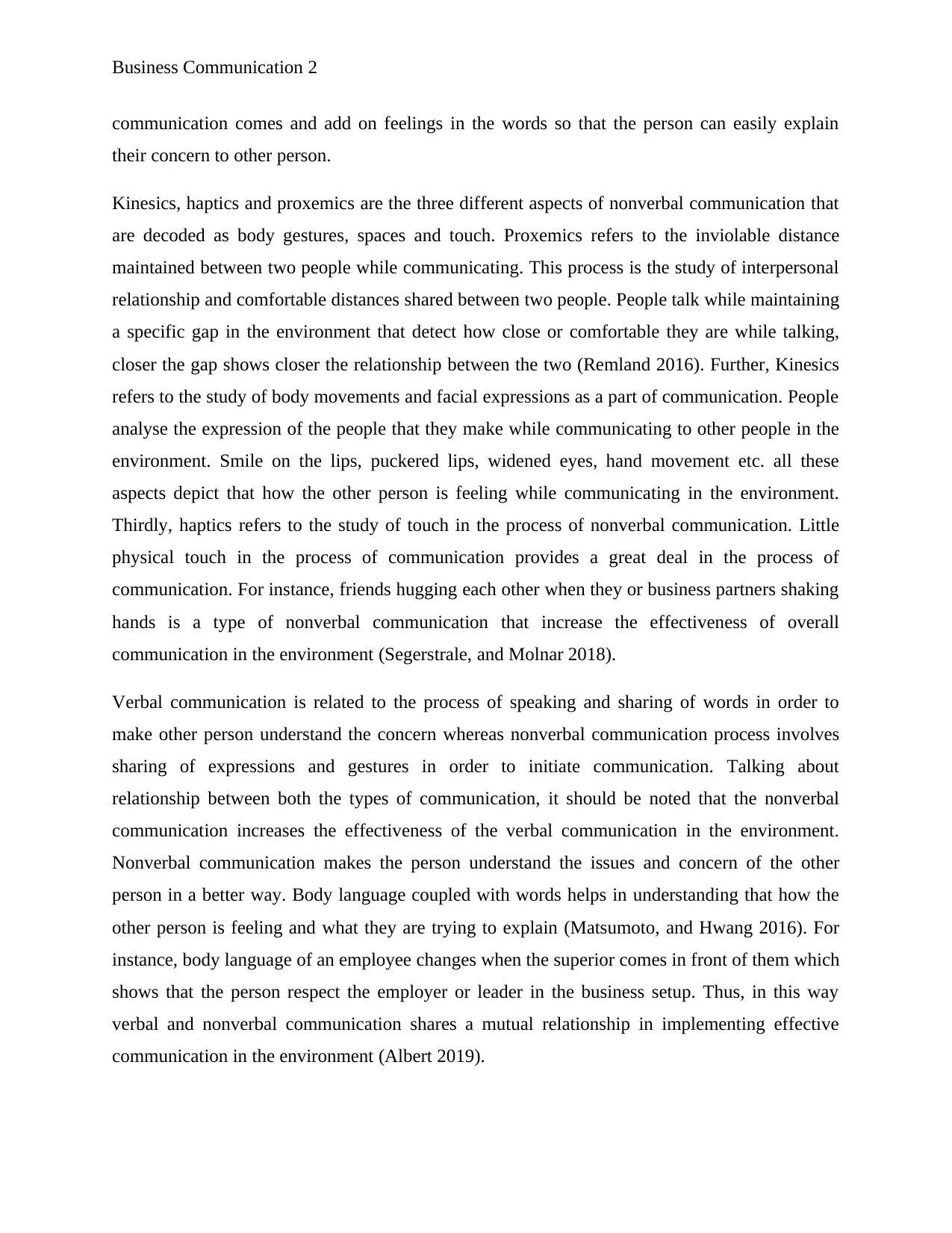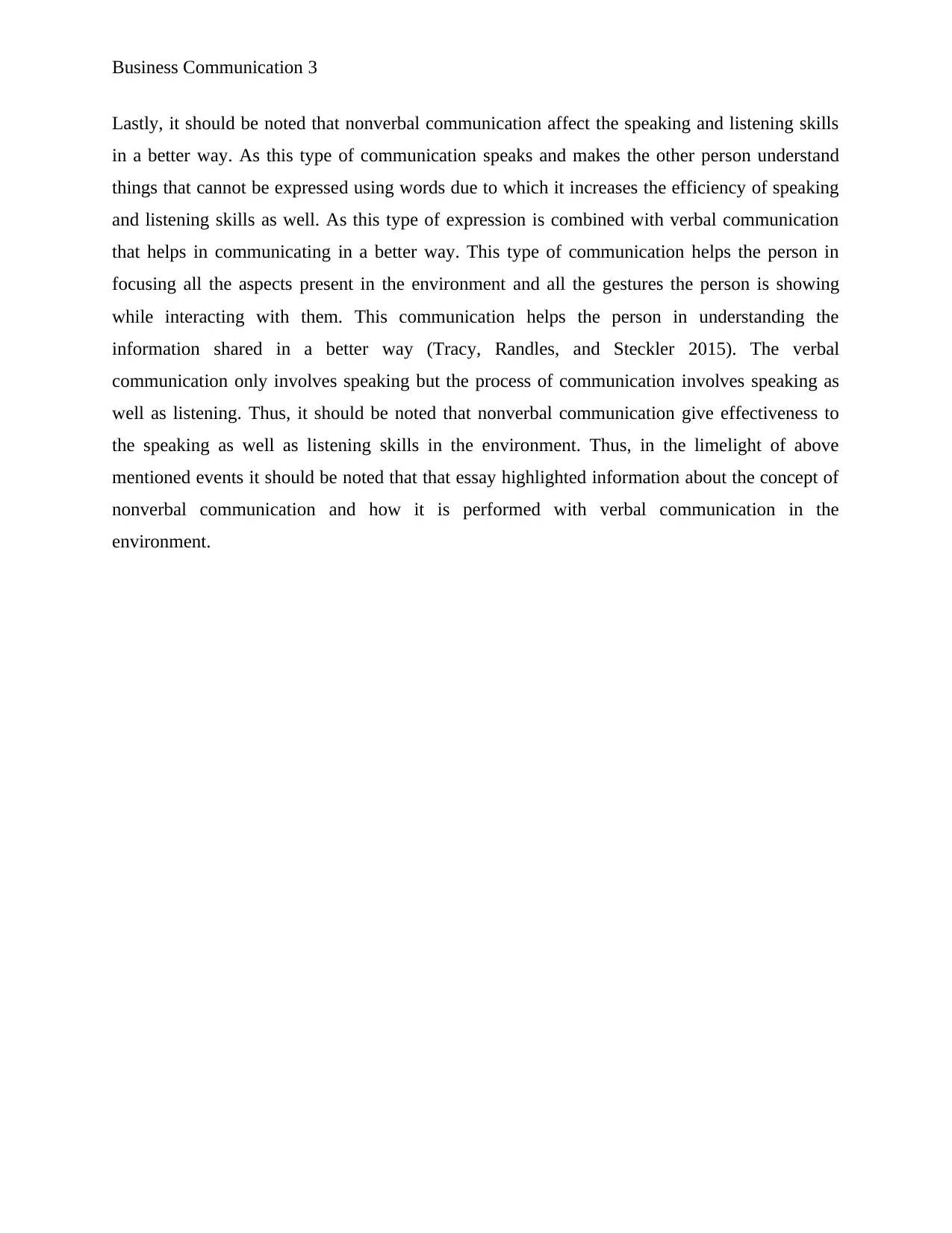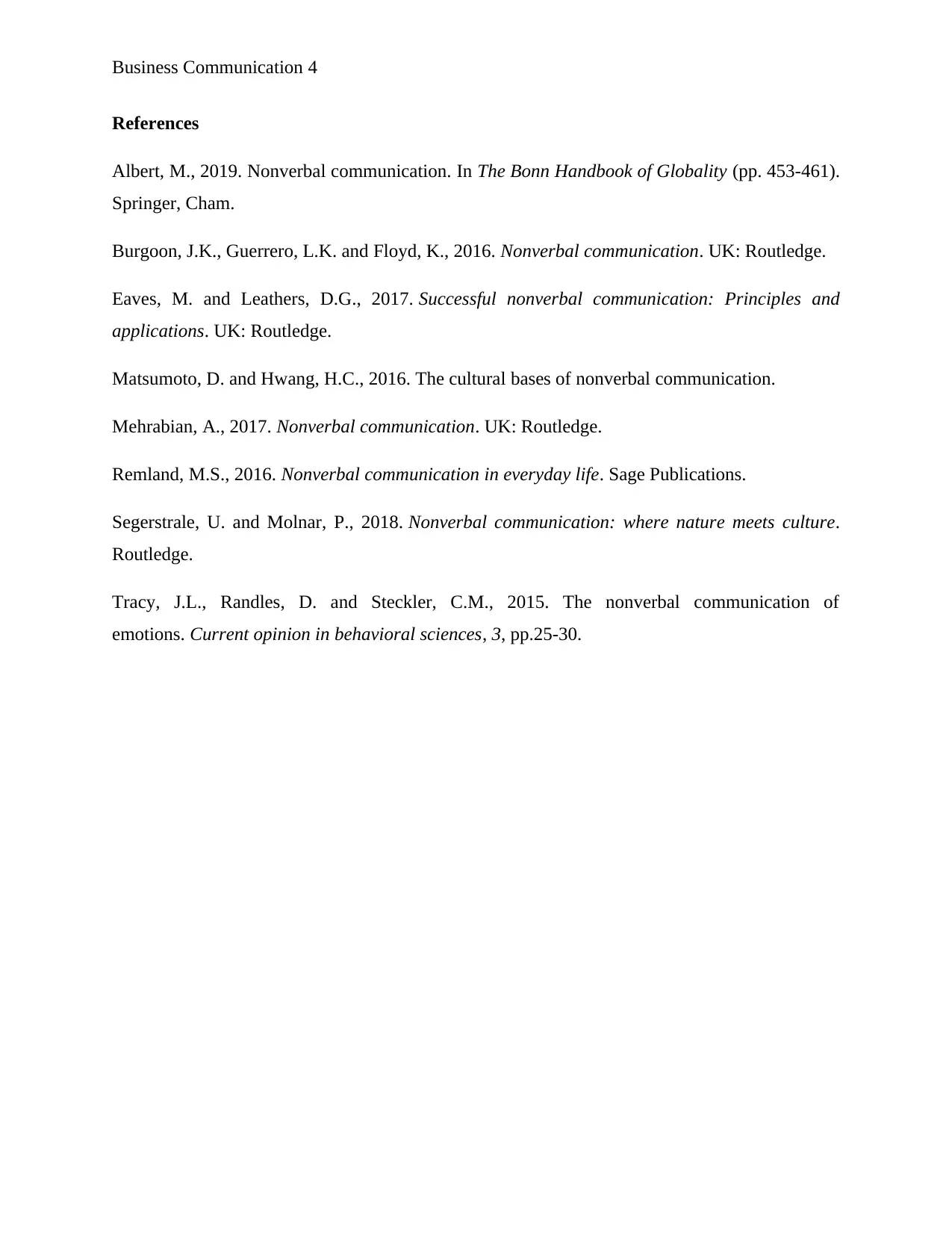Analyzing Nonverbal Communication in Business Environment Essay
VerifiedAdded on 2022/11/10
|5
|1260
|149
Essay
AI Summary
This essay delves into the critical role of nonverbal communication within a business context. It elucidates various facets of nonverbal communication, including eye contact, facial expressions, gestures, body language, and proximity, highlighting their significance in conveying messages effectively. The essay further explores the different types of nonverbal communication, such as kinesics (body movements), haptics (touch), and proxemics (personal space), and their influence on interpersonal relationships and communication dynamics. It emphasizes the synergy between verbal and nonverbal communication, demonstrating how nonverbal cues augment verbal messages to enhance clarity and understanding. Furthermore, the essay underscores the impact of nonverbal communication on speaking and listening skills, emphasizing its ability to convey emotions and unspoken information, thus improving overall communication efficiency. The essay concludes by reiterating the importance of nonverbal communication in fostering effective interactions within a business environment.

Running Head: Business Communication
Business Communication
[Type the document subtitle]
Laptop04011
[Pick the date]
Business Communication
[Type the document subtitle]
Laptop04011
[Pick the date]
Paraphrase This Document
Need a fresh take? Get an instant paraphrase of this document with our AI Paraphraser

Business Communication 1
Nonverbal communication
Nonverbal communication refers to the process of communication in which speaking is not
involved as people interact through the expressions like eye contact, gesture, facial expressions
etc. This type of communication plays a lead role in implement effective communication in an
environment. Both the types of communication verbal and nonverbal together help in sharing of
ideas in the right manner (Mehrabian 2017). The below mentioned essay highlight the details
about the nonverbal communication present in the environment, its role and how it affects people
in their listening capabilities.
There are various types of nonverbal communication prevailing in the environment like, eye
contact, proximity, facial expression, humour, body language, posture and body orientation,
touch, visual communication, personal appearance, symbol. Facial expression is responsible for
vast proportion of nonverbal communication. Facial expression of a person helps the other
person to clearly understand that how they are feeling. The facial expressions of a person can
easily depict whether they are feeling happy or sad in the environment. Secondly, gestures of a
person also help the other person to understand what they are trying to express. For instance,
waving, pointing finger to other person or indicating numeric amount can be explained using
gestures in the environment. These gestures also let the other person understand that how the
person is feeling (Burgoon, Guerrero, and Floyd 2016).
Nonverbal communication is the type of communication that is performed through expressions in
the environment. Nonverbal communication plays a lead role in helping other people to
communicate and understand them in the environment. This type of communication can help the
person in understanding that the other person is happy or sad to hear the news given to them in
the environment. Every time it is not important to share dialogues to express the views and
opinions as gesture also help in understanding the concern of the person. Taking an example of a
business environment, when a new announcement is made at the floor, the manager get to know
that who is happy or sad after listening the news (Eaves, and Leathers 2017). The manager does
not need to talk to each and every employee to understand their behaviour as their gesture can
easily make them understand that how they are feeling. Also, it should be noted that many times,
the words fall short while explaining things to people in the environment, then nonverbal
Nonverbal communication
Nonverbal communication refers to the process of communication in which speaking is not
involved as people interact through the expressions like eye contact, gesture, facial expressions
etc. This type of communication plays a lead role in implement effective communication in an
environment. Both the types of communication verbal and nonverbal together help in sharing of
ideas in the right manner (Mehrabian 2017). The below mentioned essay highlight the details
about the nonverbal communication present in the environment, its role and how it affects people
in their listening capabilities.
There are various types of nonverbal communication prevailing in the environment like, eye
contact, proximity, facial expression, humour, body language, posture and body orientation,
touch, visual communication, personal appearance, symbol. Facial expression is responsible for
vast proportion of nonverbal communication. Facial expression of a person helps the other
person to clearly understand that how they are feeling. The facial expressions of a person can
easily depict whether they are feeling happy or sad in the environment. Secondly, gestures of a
person also help the other person to understand what they are trying to express. For instance,
waving, pointing finger to other person or indicating numeric amount can be explained using
gestures in the environment. These gestures also let the other person understand that how the
person is feeling (Burgoon, Guerrero, and Floyd 2016).
Nonverbal communication is the type of communication that is performed through expressions in
the environment. Nonverbal communication plays a lead role in helping other people to
communicate and understand them in the environment. This type of communication can help the
person in understanding that the other person is happy or sad to hear the news given to them in
the environment. Every time it is not important to share dialogues to express the views and
opinions as gesture also help in understanding the concern of the person. Taking an example of a
business environment, when a new announcement is made at the floor, the manager get to know
that who is happy or sad after listening the news (Eaves, and Leathers 2017). The manager does
not need to talk to each and every employee to understand their behaviour as their gesture can
easily make them understand that how they are feeling. Also, it should be noted that many times,
the words fall short while explaining things to people in the environment, then nonverbal

Business Communication 2
communication comes and add on feelings in the words so that the person can easily explain
their concern to other person.
Kinesics, haptics and proxemics are the three different aspects of nonverbal communication that
are decoded as body gestures, spaces and touch. Proxemics refers to the inviolable distance
maintained between two people while communicating. This process is the study of interpersonal
relationship and comfortable distances shared between two people. People talk while maintaining
a specific gap in the environment that detect how close or comfortable they are while talking,
closer the gap shows closer the relationship between the two (Remland 2016). Further, Kinesics
refers to the study of body movements and facial expressions as a part of communication. People
analyse the expression of the people that they make while communicating to other people in the
environment. Smile on the lips, puckered lips, widened eyes, hand movement etc. all these
aspects depict that how the other person is feeling while communicating in the environment.
Thirdly, haptics refers to the study of touch in the process of nonverbal communication. Little
physical touch in the process of communication provides a great deal in the process of
communication. For instance, friends hugging each other when they or business partners shaking
hands is a type of nonverbal communication that increase the effectiveness of overall
communication in the environment (Segerstrale, and Molnar 2018).
Verbal communication is related to the process of speaking and sharing of words in order to
make other person understand the concern whereas nonverbal communication process involves
sharing of expressions and gestures in order to initiate communication. Talking about
relationship between both the types of communication, it should be noted that the nonverbal
communication increases the effectiveness of the verbal communication in the environment.
Nonverbal communication makes the person understand the issues and concern of the other
person in a better way. Body language coupled with words helps in understanding that how the
other person is feeling and what they are trying to explain (Matsumoto, and Hwang 2016). For
instance, body language of an employee changes when the superior comes in front of them which
shows that the person respect the employer or leader in the business setup. Thus, in this way
verbal and nonverbal communication shares a mutual relationship in implementing effective
communication in the environment (Albert 2019).
communication comes and add on feelings in the words so that the person can easily explain
their concern to other person.
Kinesics, haptics and proxemics are the three different aspects of nonverbal communication that
are decoded as body gestures, spaces and touch. Proxemics refers to the inviolable distance
maintained between two people while communicating. This process is the study of interpersonal
relationship and comfortable distances shared between two people. People talk while maintaining
a specific gap in the environment that detect how close or comfortable they are while talking,
closer the gap shows closer the relationship between the two (Remland 2016). Further, Kinesics
refers to the study of body movements and facial expressions as a part of communication. People
analyse the expression of the people that they make while communicating to other people in the
environment. Smile on the lips, puckered lips, widened eyes, hand movement etc. all these
aspects depict that how the other person is feeling while communicating in the environment.
Thirdly, haptics refers to the study of touch in the process of nonverbal communication. Little
physical touch in the process of communication provides a great deal in the process of
communication. For instance, friends hugging each other when they or business partners shaking
hands is a type of nonverbal communication that increase the effectiveness of overall
communication in the environment (Segerstrale, and Molnar 2018).
Verbal communication is related to the process of speaking and sharing of words in order to
make other person understand the concern whereas nonverbal communication process involves
sharing of expressions and gestures in order to initiate communication. Talking about
relationship between both the types of communication, it should be noted that the nonverbal
communication increases the effectiveness of the verbal communication in the environment.
Nonverbal communication makes the person understand the issues and concern of the other
person in a better way. Body language coupled with words helps in understanding that how the
other person is feeling and what they are trying to explain (Matsumoto, and Hwang 2016). For
instance, body language of an employee changes when the superior comes in front of them which
shows that the person respect the employer or leader in the business setup. Thus, in this way
verbal and nonverbal communication shares a mutual relationship in implementing effective
communication in the environment (Albert 2019).
⊘ This is a preview!⊘
Do you want full access?
Subscribe today to unlock all pages.

Trusted by 1+ million students worldwide

Business Communication 3
Lastly, it should be noted that nonverbal communication affect the speaking and listening skills
in a better way. As this type of communication speaks and makes the other person understand
things that cannot be expressed using words due to which it increases the efficiency of speaking
and listening skills as well. As this type of expression is combined with verbal communication
that helps in communicating in a better way. This type of communication helps the person in
focusing all the aspects present in the environment and all the gestures the person is showing
while interacting with them. This communication helps the person in understanding the
information shared in a better way (Tracy, Randles, and Steckler 2015). The verbal
communication only involves speaking but the process of communication involves speaking as
well as listening. Thus, it should be noted that nonverbal communication give effectiveness to
the speaking as well as listening skills in the environment. Thus, in the limelight of above
mentioned events it should be noted that that essay highlighted information about the concept of
nonverbal communication and how it is performed with verbal communication in the
environment.
Lastly, it should be noted that nonverbal communication affect the speaking and listening skills
in a better way. As this type of communication speaks and makes the other person understand
things that cannot be expressed using words due to which it increases the efficiency of speaking
and listening skills as well. As this type of expression is combined with verbal communication
that helps in communicating in a better way. This type of communication helps the person in
focusing all the aspects present in the environment and all the gestures the person is showing
while interacting with them. This communication helps the person in understanding the
information shared in a better way (Tracy, Randles, and Steckler 2015). The verbal
communication only involves speaking but the process of communication involves speaking as
well as listening. Thus, it should be noted that nonverbal communication give effectiveness to
the speaking as well as listening skills in the environment. Thus, in the limelight of above
mentioned events it should be noted that that essay highlighted information about the concept of
nonverbal communication and how it is performed with verbal communication in the
environment.
Paraphrase This Document
Need a fresh take? Get an instant paraphrase of this document with our AI Paraphraser

Business Communication 4
References
Albert, M., 2019. Nonverbal communication. In The Bonn Handbook of Globality (pp. 453-461).
Springer, Cham.
Burgoon, J.K., Guerrero, L.K. and Floyd, K., 2016. Nonverbal communication. UK: Routledge.
Eaves, M. and Leathers, D.G., 2017. Successful nonverbal communication: Principles and
applications. UK: Routledge.
Matsumoto, D. and Hwang, H.C., 2016. The cultural bases of nonverbal communication.
Mehrabian, A., 2017. Nonverbal communication. UK: Routledge.
Remland, M.S., 2016. Nonverbal communication in everyday life. Sage Publications.
Segerstrale, U. and Molnar, P., 2018. Nonverbal communication: where nature meets culture.
Routledge.
Tracy, J.L., Randles, D. and Steckler, C.M., 2015. The nonverbal communication of
emotions. Current opinion in behavioral sciences, 3, pp.25-30.
References
Albert, M., 2019. Nonverbal communication. In The Bonn Handbook of Globality (pp. 453-461).
Springer, Cham.
Burgoon, J.K., Guerrero, L.K. and Floyd, K., 2016. Nonverbal communication. UK: Routledge.
Eaves, M. and Leathers, D.G., 2017. Successful nonverbal communication: Principles and
applications. UK: Routledge.
Matsumoto, D. and Hwang, H.C., 2016. The cultural bases of nonverbal communication.
Mehrabian, A., 2017. Nonverbal communication. UK: Routledge.
Remland, M.S., 2016. Nonverbal communication in everyday life. Sage Publications.
Segerstrale, U. and Molnar, P., 2018. Nonverbal communication: where nature meets culture.
Routledge.
Tracy, J.L., Randles, D. and Steckler, C.M., 2015. The nonverbal communication of
emotions. Current opinion in behavioral sciences, 3, pp.25-30.
1 out of 5
Related Documents
Your All-in-One AI-Powered Toolkit for Academic Success.
+13062052269
info@desklib.com
Available 24*7 on WhatsApp / Email
![[object Object]](/_next/static/media/star-bottom.7253800d.svg)
Unlock your academic potential
Copyright © 2020–2025 A2Z Services. All Rights Reserved. Developed and managed by ZUCOL.




